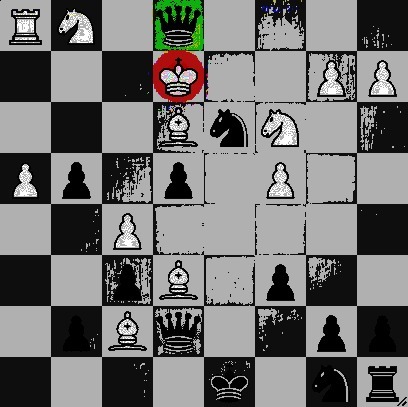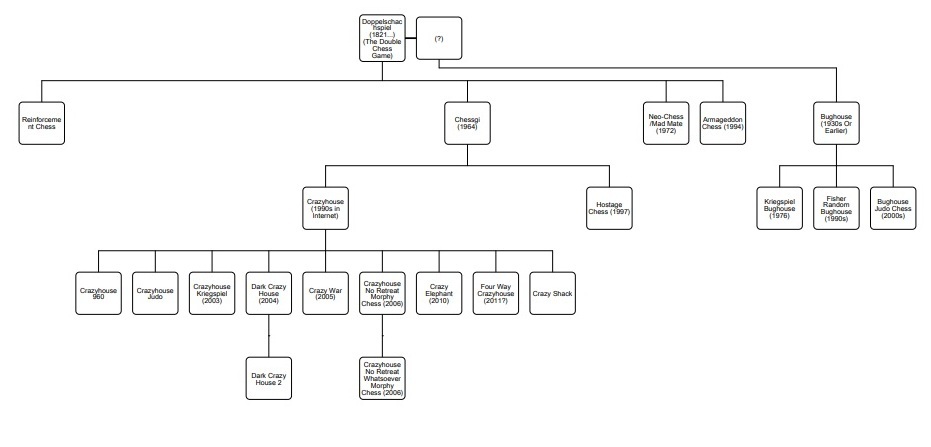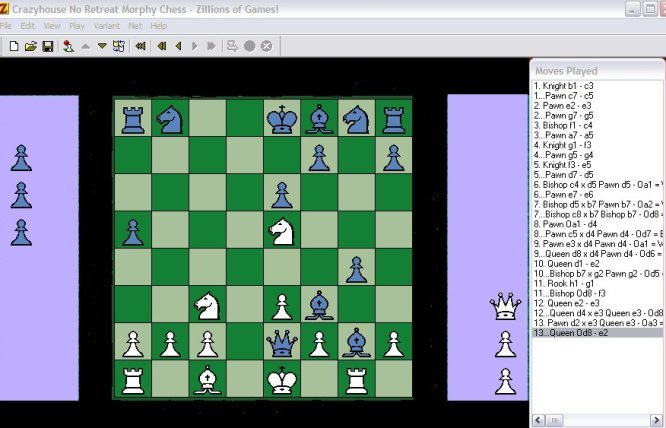crazymaharajah (![[personal profile]](https://www.dreamwidth.org/img/silk/identity/user.png) crazymaharajah) wrote2022-03-19 03:32 am
crazymaharajah) wrote2022-03-19 03:32 am
Crazyhouse genealogy

The first draft of this genealogy looked like a simple addition. I created a diagram where I tried to show the evolution of crazy and bug and hybrids games.
But a little later I got some new material. It was also due to my communication with the visualdennis, who could translate excerpts from old German books. In our discussion we discussed sources of scattered information and exchanged the links we found.
This research progressed in several directions at once. Part of the work involved finding historical sources and we found some traces in chess literature before 1840.
I also saw for myself the need to create a classification of the different names and varieties of crazy&bug that mostly date back to the 20th century.
This fragment contains basic information about the development of crazyhouse:
"Disposition of captives (captured unit not removed from play)
Cv1 -- Conversion
In conversion chesses, captured enemy units are not removed from play, but instead become friendly units of the same species. The best known form of this is Chessgi, a popular variant derived from the Japanese game of shogi. A converted unit belongs to the captor, who can re-enter it on a vacant square on any later move, instead of moving a unit already on the board. The set of captured units is called the reserve, and the placing of a unit from the reserve instead of moving is called a drop. A pawn may not be dropped on its eighth rank. A pawn placed on its first rank can singlestep or capture normally. Any pawn on its second rank can doublestep. A rook dropped at a/h-1/8 can castle. Pawns promote normally, and retain their rank when captured.
Several other versions of this idea differ mainly in restrictions on drops. In Neo-Chess (independently invented by Randolph in 1972), pawns promote by being exchanged for pieces from the opponent's reserve (a pawn moved to the eighth rank when the opponent has no pieces in reserve is immobile for the rest of the game); no unit may be dropped on the eighth rank (the last rule was dropped in a later version called Mad Mate). The commercial sets for Randolph's Neo-Chess/Mad Mate have round, double-sided pieces (with orthodox symbols) which are flipped over (as in reversi) to show the capturing player's color (shogi pieces are uncolored pentagons which point in the direction of the opponent to show which player they belong to. Dekle's Chessgi improves defense in standard chessgi by prohibiting all drops giving check (or alternatively using dragon horses instead of bishops -- adding the wazir move to their normal power); pawns promote only to counselors (non-royal kings, useful for defense) and revert to pawns when captured (see also [232, 340]). Robert Bruce earlier proposed a game [121] with restrictions similar to shogi -- pawns cannot be dropped to give mate, pawns cannot be dropped on their eighth rank, and promoted pieces revert to pawns when captured. Chessgi has also been combined with Scottish C [538]. Tandem C is a chessgi variant which resembles Double Bughouse (Cy4), but needs only a single set and two players.
Two variants, using chips to 'pay' for reentered units, have been devised to allow players more options in managing reserves and planning attacks. In Token C, the capturing player receives chips (according to the usual values P=1, N/B=3, R=5, Q=9) for capturing a unit. At the start of any future turn a player holding chips may trade the corresponding number of chips for a unit of his choice (it need not be one captured earlier). The player then takes his usual turn, either reentering a unit as in chessgi (but not the one he just 'bought') or moving a unit already on the board. In Bankhouse C, each player starts the game with 25 tokens. Captured units join the captor's force as usual; a player may reenter a unit on a vacant corresponding first rank square (e.g. White may enter a converted knight at b1 or g1) by paying the opponent the required number of chips (values as above). In addition, a player may ransom a lost unit (from the opponent's reserve to his own) at the same cost, paying a second time when he re-enters it. Any number of units may be ransomed on one turn, but at most one may be re-entered on the same turn.
Conversion C is a co-chess (Cu1) in which enemy units on co-squares are converted to friendly units of the same type; friendly units are unaffected (but see [201]). A threat to convert the enemy king is check, analogous to ordinary check. Orthodox captures and checks are also permitted. Cohen suggests that orthodox (replacement) capture be allowed by pawns only (see also Co-Capture).
The idea of conversion might be combined with other variants, especially those using non-replacement capture. It is possible, for example, to imagine Rifle Conversion, in which units 'shot' by rifle capture become friendly units (in order to make this playable, a player may not reconvert a unit which her opponent converted on the previous half-move). Similar to this is Turncoat C, in which any friendly unit attacked by the opponent at the start and end of a turn changes (at the end of that turn) into an enemy unit (e.g. 1 e4 e5 2 Qh5 g6 (Black pawn at h7 becomes White)).
When ordinary replacement capture is used, however, the capture square is occupied by the captor, and something must be done with the converted unit (multiple occupancy is possible, but the same rule as above, forbidding immediate recaptures on the same square, is needed). In two variants described in JENO, the converted unit is immediately moved elsewhere. We will use the name Conversion Circe for Tressau's variant, in which the converted unit is placed on the appropriate starting square if vacant (as in the problem Circe convention in Cv2). Boyer proposed a variant in which the captor immediately relocates the converted unit to any vacant square (bishop on the same color it was captured on; pawns not on the eighth rank); we will call this Conversion Bughouse."
I should clarify that this is a reprint from journal Chess Variants, which contains much information about both the games and the communities of players, inventors, and historians. This is hard to come by these days. Of course the Fergus Duniho site is the most authoritative for fans of chess variants. But as far as crazy&bug is concerned, only basic information without details.

This is a classical scheme of variants related to Crazyhouse that were created between the first half of the 19th century and the late 2010s. It does not include many other hybrids.
Unknow game is ancestor of Bughouse only presumably, there is no reliable study of his origin yet, as I mentioned before, the oldest Bughouse rules date back to 1947.
There are no other hybrids in this scheme - variations of Bughouse described in Variant Chess magazine and Pritchard’s Encyclopedia of Chess Variants and some other crazyhouse prototypes, Pocket Knight, experimental versions of Tiszta Bolondokháza and LaoTzu Chess and others from schemingmind.com, hybrid Mad Elephant Chessgi.
The time of Crazy Shack invention is unknown to me.
I also did not add pychess.org variants - Capahouse, Capahouse 960, S-House, Grandhouse and liantichess.herokuapp.com - Coffeehouse, Antihouse and their sub-variants in hybrid along with 960.
The same goes for judochess.com (shizmoo - tempestchess - judochess) where there was in 2000s Crazyhouse Judo, his I did not add to genealogy, but I added Four Way Crazyhouse and Bughouse Judo.
Fisher Random Bughouse existed in mid 2000s at chess.sipay.ru. Currently there is onlinea.4smart.eu where you can play.
I would have had to add too many other parents for different hybrids. In addition there is another reason - some of the variants could only be theoretical and we do not even know if they were played at all for example variations bughouse with a 3x7 board and etc.
I've seen a lot description of other different variations with elements of crazyhouse and a more complete classification may look like 1... 2... 1.1... 1.1.1... 1.1.2... 2.1... etc. or it could be an extensive family tree where crazy variants will be marked with a certain color and the other parents will remain transparent.
On reddit and elsewhere, people are constantly coming up with new variants chess.
Crazyhouse No Retreat Morphy Chess
https://www.chessvariants.com/rules/crazyhouse-no-retreat-morphy-chess

Crazy Elephant
https://www.schemingmind.com/home/knowledgebase.aspx?article_id=114
https://www.aurochs.org/aurlog/2010/09/10/crazy-elephant-chess-variant/
Mad Elephant Chessgi (a sub-variant of Mad Elephant Chess)
www.chessvariants.com/diffmove.dir/mad-elephant.html#:~:text=In%20Mad%20Elephant%20Chess%20a,line%20in%20front%20of%20it.
Kriegspiel Bughouse
"Kriegspiel Bughouse, invented at the New Cincinnati Chess Club, is played by four players, two against two. Each player can see his teammate's board but not the opponents'. The players move in rotation; passes are legal but the player who passed first must play after eight consecutive passes. Captured units are passed to the teammate as in Double Bughouse (Cy4). move away from the disappearance square."
Bughouse judo chess (?)
I do not know when it was first implemented by the creators of judochess.com and at the time of writing this chapter the site is not working, he has ceased to exist at the beginning of 2021.
One of my main arguments about the ancient origin of the captured drop rule is that it is the most fundamental idea and it can come to any person, any child learning to play chess.